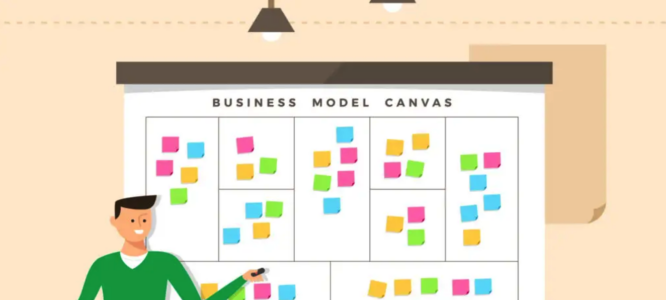The Business Model Canvas: A Comprehensive Guide for Bootstrapped Entrepreneurs

The Business Model Canvas (BMC) is a strategic tool designed to help entrepreneurs visualize, develop, and refine their business ideas. Introduced by Alexander Osterwalder in Business Model Generation, the BMC is widely regarded as a practical and straightforward framework for both startups and established businesses.
This article explores the BMC’s key components, practical examples, and actionable steps for bootstrapped businesses to apply it effectively.
What is the Business Model Canvas?
The Business Model Canvas is a one-page blueprint comprising nine interconnected building blocks that represent the core aspects of any business. It replaces lengthy, text-heavy business plans with a visual and dynamic approach, allowing founders to quickly iterate and adapt.
Here are the nine building blocks of the BMC:
- Customer Segments
- Value Propositions
- Channels
- Customer Relationships
- Revenue Streams
- Key Resources
- Key Activities
- Key Partnerships
- Cost Structure
How to Use the Business Model Canvas When Bootstrapping a Business
Bootstrapped businesses often operate with tight budgets and limited resources. Using the BMC can help prioritize efforts, minimize risks, and identify opportunities for growth without significant capital investment. Below is a step-by-step guide with practical examples:
1. Customer Segments: Define Your Target Audience
Understanding your customers is foundational. In bootstrapping, focus on a niche market to conserve resources.
Example:
You’re launching a minimalist productivity app. Your primary customer segments might include:
- Freelancers looking to optimize workflows.
- Small business owners managing tasks and deadlines.
Actionable Tip:
Use surveys or free tools like Google Forms to validate your assumptions about potential customers.
2. Value Propositions: Solve a Pain Point
A value proposition is the unique solution your product or service offers. It should resonate strongly with your customer segments.
Example:
The productivity app’s value proposition could be: “Streamline task management with an intuitive, clutter-free interface designed for small teams.”
Actionable Tip:
Create a Minimum Viable Product (MVP) and gather feedback early to refine your value proposition.
3. Channels: Reach Your Customers
Channels describe how you deliver your product or service to customers. Bootstrapping means prioritizing cost-effective channels.
Example:
- Owned Channels: Your website, blog, or social media.
- Earned Channels: Reviews, organic search, or word-of-mouth.
Actionable Tip:
Leverage free or low-cost tools like Instagram, LinkedIn, or Google My Business to promote your product.
4. Customer Relationships: Build Loyalty
Developing strong customer relationships is critical when resources are limited.
Example:
Offer personalized onboarding for your productivity app and maintain engagement through a monthly newsletter with tips and updates.
Actionable Tip:
Use free CRM tools like HubSpot or Zoho to track interactions with early adopters.
5. Revenue Streams: Generate Income
Revenue streams outline how your business will make money. For bootstrapped startups, testing multiple revenue models can help identify what works best.
Example:
The productivity app could offer:
- A freemium model with in-app upgrades.
- A subscription plan for premium features.
Actionable Tip:
Start with low-cost pricing to attract early adopters, then adjust based on market response.
6. Key Resources: Focus on Essentials
Identify the critical resources needed to create and deliver your value proposition.
Example:
For a SaaS business, key resources might include:
- A skilled developer.
- Reliable cloud infrastructure (e.g., AWS or Azure).
Actionable Tip:
Bootstrap by hiring freelancers on platforms like Upwork or leveraging no-code tools such as Webflow or Bubble.
7. Key Activities: Prioritize Your Efforts
Key activities are the tasks required to make your business model work. For bootstrapped businesses, staying lean is essential.
Example:
For the productivity app, key activities include:
- Building and maintaining the software.
- Marketing through content creation.
Actionable Tip:
Use the 80/20 rule to focus on activities that deliver the most impact with minimal effort.
8. Key Partnerships: Collaborate Strategically
Partnerships can help you fill gaps without significant investment.
Example:
Collaborate with productivity bloggers or influencers to promote your app in exchange for affiliate commissions or free subscriptions.
Actionable Tip:
Identify complementary businesses and propose mutually beneficial partnerships.
9. Cost Structure: Keep Expenses Low
Cost structure defines the major expenses your business will incur. Bootstrapping requires ruthless prioritization.
Example:
For the productivity app:
- Variable Costs: Cloud storage based on user activity.
- Fixed Costs: Domain registration and basic software subscriptions.
Actionable Tip:
Track every expense and evaluate ROI. Use tools like Wave or QuickBooks for budgeting.
Benefits of Using the Business Model Canvas
- Clarity: Provides a clear snapshot of your business.
- Flexibility: Allows for quick adjustments based on feedback.
- Collaboration: Encourages teamwork and shared understanding.
- Efficiency: Saves time compared to traditional business plans.
Conclusion: Start Your Business Journey with Confidence
For bootstrapped entrepreneurs, the Business Model Canvas is an invaluable tool. It simplifies complex ideas, focuses on what matters most, and provides a roadmap for sustainable growth.
Begin by downloading a free BMC template and filling in each section. Iterate as you learn more about your market, customers, and resources. With a clear strategy and disciplined execution, your bootstrapped business can thrive even in competitive markets.
Are you using the Business Model Canvas for your business? Share your experiences and insights in the comments!







